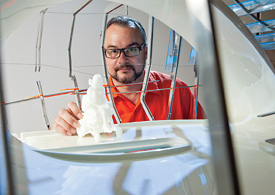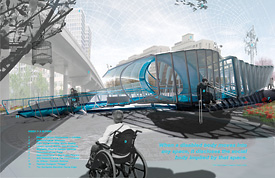

Photo by Austin Thomason, U-M Photo Services.
When Robert Adams’ and Dawn Gilpin’s daughter Celeste was diagnosed with muscular dystrophy and began using a powered wheelchair, Adams had an idea. He wanted to invent a special ramp that would foster inclusion for disabled and non-disabled people.
Adams is assistant professor of architecture at Taubman College of Architecture and Urban Planning and Gilpin is a lecturer in architecture at the Taubman College.
With research support from the university, and a Research Through Making Grant from the Taubman College, Adams, developed the Asclepius Machine, named after the Greek god of the medical arts.
The Asclepius Machine is a work of architecture — a complex wheelchair accessible ramp — connected to a network of performance-based interactions. Like an amusement park ride, The Asclepius Machine is an apparatus that is staged anywhere, or annexed to any building or structure requiring ramp technology to increase access.
The Asclepius Machine has a series of artificial pneumatic muscles that allow the walls and an elastic membrane to gently open and close as a person moves through the space. “As one moves through the ramp, a sound similar to a person breathing is produced from the compressed air in the muscles,” Adams says of his invention, which often is compared to a carnival ride.
Looking towards the future, Adams wants to develop the Asclepius Machine to build a new way of understanding the disability culture. “Disability is pervasive, cutting across class, culture, race,” he says. “In America interacting with disabled people is awkward and strange for many people. This piece of architecture can get people excited about a wheelchair ramp, and provide a completely new concept for how we perceive disability,” says Adams, who also has muscular dystrophy.
What moment in the classroom or lab stands out as the most memorable?
The moments when a conversation around a student’s project — be it design, architecture or some research agenda — begins to vibrate wildly.
What can’t you live without?
Life without contradictions would certainly be flat. Also these 005 Micron Pigma pens I always have in my shirt pocket. I really don’t even like them anymore. They are just part of the daily ritual of placing pens in the pocket. When they are not there I have serious problems.
What is your favorite spot on campus?
The 300-foot water channel in the Marine Hydrodynamics Laboratory; The Detroit Observatory built as the first research building on campus; black box Video Studio at the Duderstadt; the Michigan Academic Computing Center and its sweet smell of data.
What inspires you?
Seeing Robert Wilson’s “Einstein on the Beach” at the Power Center with my traveling companions Dawn Gilpin and Celeste Adams.
What are you currently reading?
“Deng Xiaoping and the Transformation of China” by Ezra F. Vogel.
Who had the greatest influence on your career path?
My professors, mentors, friends, colleagues and architects — Robert Mangurian and Mary-Ann Ray who are the co-founders and directors at B.A.S.E. Also a designer by the name of Twiggy has steered my practice in interesting directions.
Adams eventually wants introduce the Asclepius Machine to the public. He has plans to build a model at The Watermill Center this summer, and ideally on the Medical Campus or other high profile sites in New York or Washington, D.C. A smaller scale version of the ramp is also being designed to be loaded onto a truck to travel around the country at events such as the X-Games, disability rights events, or conferences for military veterans with disabilities.
Adams says he hopes the machine is able to provide more than an unexpected experience. “I’m really hoping this work can help overcome the larger issues of disability and the many soft forms of discrimination prevalent in the city,” Adams says.
The wheelchair ramp isn’t the only notable creation by Adams, who began teaching at the Taubman College after spending time in a medieval town in Switzerland as a teaching fellow at SCI-Arc (Southern California Institute of Architecture). “When I was first hired at Taubman College, I mentioned that I wanted to start a program in China because of the huge surge in architecture in Beijing after they were awarded the Olympic games,” he says.
Adams cofounded a program at U-M called BASE, Beijing Architecture Studio Enterprise, with his colleagues, from Los Angeles. “Every spring semester we bring students to Beijing from the Taubman College and the Graham Institute, and other institutions to study and pursue various projects on rural and urban China,” Adams says. This past year Adams met with governmental officials at the China Disabled Persons Federation, and several NGOs working on disability issues in Beijing. He is expanding his research in China to focus on issues of civic space and disability issues that consider new types of architecture.
The weekly Spotlight features faculty and staff members at the university. To nominate a candidate, please contact the Record staff at [email protected].

